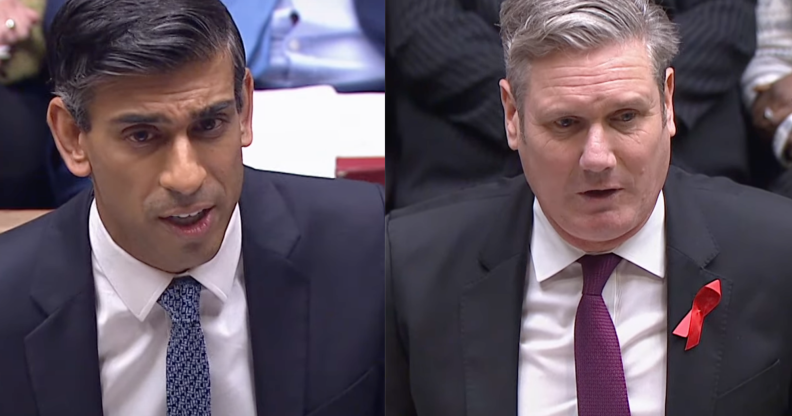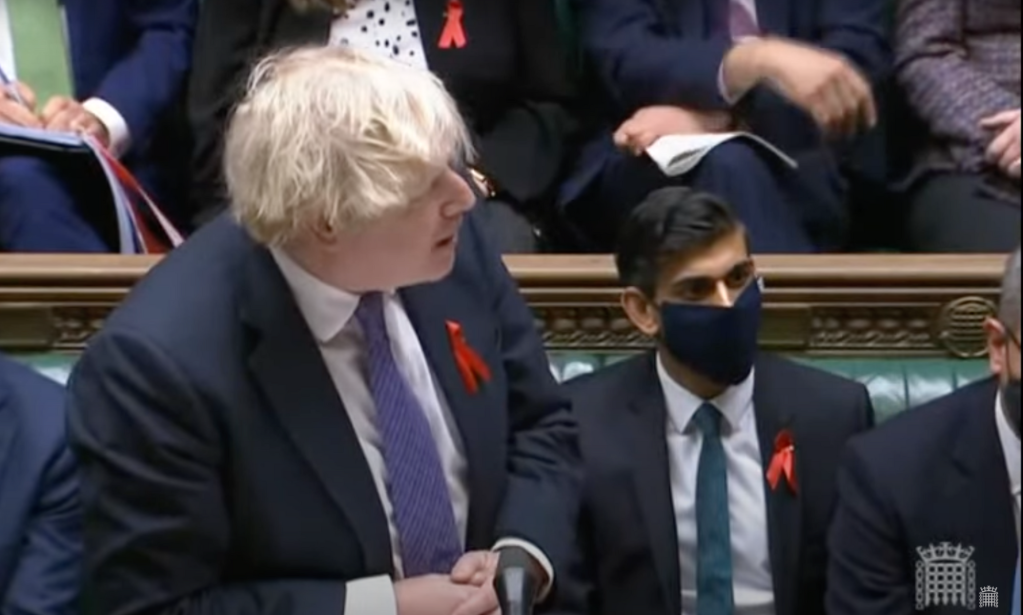Rishi Sunak didn’t wear World AIDS Day ribbon because he ‘doesn’t put things on his lapel’

HIV activists are ‘disappointed’ after Rishi Sunak was spotted without a World AIDs Day ribbon at the Prime Minister’s Questions despite other MPs showing their support. (Parliament TV)
Activists have slammed Rishi Sunak’s “disappointing” decision to not wear a red ribbon in support of World AIDS Day despite other MPs showing their support at the Prime Minister’s Questions (PMQs).
The ribbon is worn by politicians and others around the globe in support of World AIDS Day, designated on 1 December. Those watching PMQs on Wednesday (30 November) noticed the symbol was glaringly absent from Rishi Sunak’s lapel during the weekly parliamentary debate.
Yet, Labour leader Keir Starmer, Scottish National Party’s Ian Blackford and a large number of other MPs throughout the house wore red ribbons on their jackets in support. Starmer even started PMQs by recognising that World AIDS Day takes place tomorrow, acknowledging the annual opportunity for people to raise awareness and destigmatise HIV.
Kat Smithson, director of policy at the National AIDS Trust, told PinkNews it was “disappointing” Sunak chose not to wear the ribbon today and hoped he “reconsiders tomorrow”.
“The red ribbon is a symbol of solidarity with people living with HIV and remembrance for those who have died,” Smithson said. “It’s disappointing that Rishi Sunak has chosen not to wear it today and we hope he reconsiders tomorrow on World AIDS Day as a way of demonstrating support for those affected.”
Smithson added the “most important thing” Sunak can do as prime minister is to ensure the Tory government “delivers on their key commitments to get us to our collective goal of ending HIV transmissions by 2030”.
Matthew Hodson, executive director of charity aidsmap, was “surprised” Sunak didn’t wear the red ribbon because it’s been a “convention that politicians do show their support for the struggle against HIV and to remember those who died of AIDS on or around World AIDS Day”.
“His spokesperson said that he doesn’t wear pins, but he has in the past worn a poppy, so it seems curious that he chose not to wear a ribbon today,” Hodson told PinkNews. “It may be that it was actually accidental, but if so, it’s surprising that he didn’t correct that.”
Hodson noted that Sunak has made a “commitment to honouring the 2030 goal of eradicating new HIV infections in the UK” and that his “support for HIV prevention has been consistent”.
When asked about Rishi Sunak and the World AIDS Day ribbon, the prime minister’s political spokeswomen told PinkNews as a “general principle, the PM doesn’t put things on his lapel”.
Asked why that was, the spokeswomen added that the PM chooses to support causes in different ways.
Many people on social media noticed Sunak did not wear the ribbon although the majority of his frontbenchers – including Kemi Badenoch, who sat right behind Sunak during PMQs – did.
However, Rishi Sunak has worn badges and other symbols on his jacket in the past, including a World AIDS Day ribbon. He wore the red ribbon on World AIDS Day as he sat behind then-prime minister Boris Johnson during PMQs on 1 December 2021.

Hodson recalled how the iconic red ribbon was first introduced in 1991 as a symbol to raise awareness of HIV and AIDS and how he, as a young gay man, “didn’t just wear it” on World AIDS Day.
“Many of us wore it throughout the year, particularly at a time when there was no effective treatment for HIV and when our friends and lovers were getting ill and were dying,” Hodson said.
“Now that we have effective treatment and AIDS is not the killer that it once was, I use World AIDS Day as the time to remember those who lost but also to honour them by tackling HIV stigma now and fighting to ensure that everyone has access to treatment, which saves lives and prevents new infections.”

